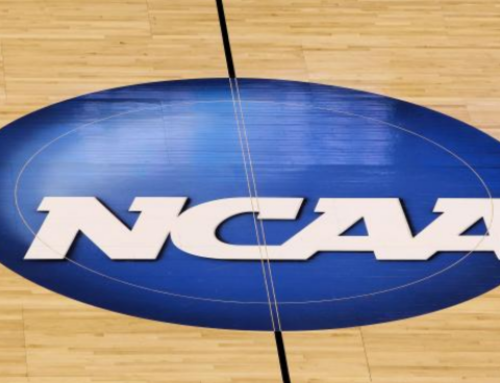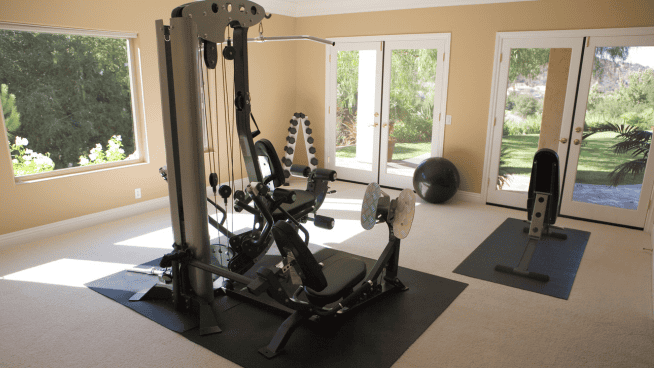Basketball’s 3-Second Rule, Explained (with Video!)
You’re watching your favorite NBA team play defense, when all of a sudden the referee blows the whistle and play stops. You lean in closer to the TV screen, dumbfounded. You saw no one get fouled, and the ref is now making a weird chopping motion three times with his arm. Next, one team’s best free-throw shooter is standing on the foul line taking one shot—and his team gets the ball back. You are lost. Everything you know about the game of basketball has been shattered.
Take a deep breath. It’s OK. The ref has called a three-second violation. What does that mean? It’s actually pretty simple.
RELATED: How to Dribble a Basketball
3-Second Violation Against the Defense
The defensive 3-second rule is meant to keep big men from planting themselves under the hoop for the full duration of the shot clock (or in high school and under, the entire possession), ready to swat away shots by any opponent who dares drive to the hoop. According to the NBA rulebook (the rule is the same for college), once an offensive player brings the ball across half-court, any defensive player inside the 16-foot lane (from the baseline to the free-throw line, commonly referred to “painted area”) must be “actively guarding an opponent within three seconds.” “Actively guarding” means being positioned within arm’s length of an offensive player and in a guarding position.
RELATED: 8 Ways to Become a Better Basketball Player
In layman’s terms, this means a defender can stray away from the man he’s guarding for no more than three seconds before having to re-establish his position an arm’s length away from his man. If he does not do this, the referee will call a 3-second violation, and the offensive team can select any player to shoot the penalty free throw. The offensive team then gets the ball back and is rewarded with another possession. Essentially, the rule can be summed up like this: inside the painted area, you must be defending a player, not the basket.
[youtube video=”c_Vz6aHWO_M” /]Check out the play above. Golden State Warriors forward David Lee (no. 10) is supposed to be defending no. 24 on the Utah Jazz, Marvin Williams. Instead, he sneaks into the paint when he thinks Jazz point guard Deron Williams is about to drive to the hole. As Williams begins to drift back out to the 3-point line, and Deron pulls his dribble back out because of a double-team, Lee elects to stay in the paint, out of arm’s length of Williams. He remains there, somewhat lost, until the ref blows the whistle and calls him for the violation.
3-Second Violation Against the Offense
An offensive player who has one or both feet in the painted area for more than three seconds can be called for a technical foul. The player must have both feet outside the paint before he can re-enter, and the referee’s three-second count begins again.
[youtube video=”XlLJyO7VCyk” /]In the video above, watch former New York Knicks center Tyson Chandler. After setting a pick for Carmelo Anthony, he rolls to the hoop, ending up deep in the painted area. As Anthony drives to his right, pulls up and passes back out to J.R. Smith, Chandler remains in the paint without stepping out to restart the three-second count. The ref catches him, blows the whistle for the violation, and the the Knicks lose possession.
RELATED: How to Shoot a Basketball Better
The lesson here? Be alert when you enter the paint, on both sides of the ball. The refs are counting.
RECOMMENDED FOR YOU
Basketball’s 3-Second Rule, Explained (with Video!)
You’re watching your favorite NBA team play defense, when all of a sudden the referee blows the whistle and play stops. You lean in closer to the TV screen, dumbfounded. You saw no one get fouled, and the ref is now making a weird chopping motion three times with his arm. Next, one team’s best free-throw shooter is standing on the foul line taking one shot—and his team gets the ball back. You are lost. Everything you know about the game of basketball has been shattered.
Take a deep breath. It’s OK. The ref has called a three-second violation. What does that mean? It’s actually pretty simple.
RELATED: How to Dribble a Basketball
3-Second Violation Against the Defense
The defensive 3-second rule is meant to keep big men from planting themselves under the hoop for the full duration of the shot clock (or in high school and under, the entire possession), ready to swat away shots by any opponent who dares drive to the hoop. According to the NBA rulebook (the rule is the same for college), once an offensive player brings the ball across half-court, any defensive player inside the 16-foot lane (from the baseline to the free-throw line, commonly referred to “painted area”) must be “actively guarding an opponent within three seconds.” “Actively guarding” means being positioned within arm’s length of an offensive player and in a guarding position.
RELATED: 8 Ways to Become a Better Basketball Player
In layman’s terms, this means a defender can stray away from the man he’s guarding for no more than three seconds before having to re-establish his position an arm’s length away from his man. If he does not do this, the referee will call a 3-second violation, and the offensive team can select any player to shoot the penalty free throw. The offensive team then gets the ball back and is rewarded with another possession. Essentially, the rule can be summed up like this: inside the painted area, you must be defending a player, not the basket.
[youtube video=”c_Vz6aHWO_M” /]Check out the play above. Golden State Warriors forward David Lee (no. 10) is supposed to be defending no. 24 on the Utah Jazz, Marvin Williams. Instead, he sneaks into the paint when he thinks Jazz point guard Deron Williams is about to drive to the hole. As Williams begins to drift back out to the 3-point line, and Deron pulls his dribble back out because of a double-team, Lee elects to stay in the paint, out of arm’s length of Williams. He remains there, somewhat lost, until the ref blows the whistle and calls him for the violation.
3-Second Violation Against the Offense
An offensive player who has one or both feet in the painted area for more than three seconds can be called for a technical foul. The player must have both feet outside the paint before he can re-enter, and the referee’s three-second count begins again.
In the video above, watch former New York Knicks center Tyson Chandler. After setting a pick for Carmelo Anthony, he rolls to the hoop, ending up deep in the painted area. As Anthony drives to his right, pulls up and passes back out to J.R. Smith, Chandler remains in the paint without stepping out to restart the three-second count. The ref catches him, blows the whistle for the violation, and the the Knicks lose possession.
RELATED: How to Shoot a Basketball Better
The lesson here? Be alert when you enter the paint, on both sides of the ball. The refs are counting.










